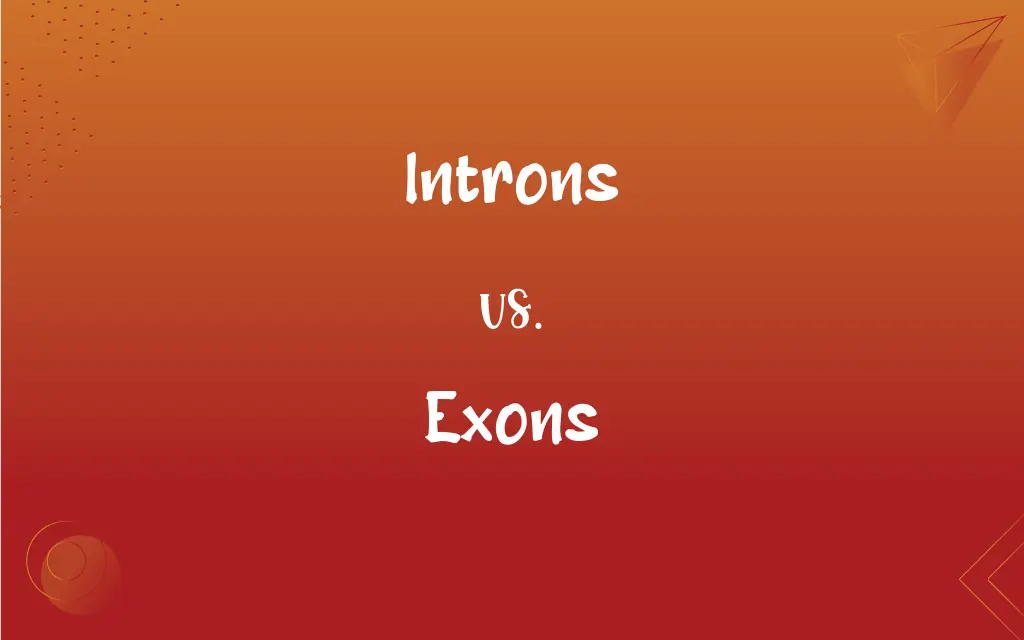Introns vs. Exons: What's the Difference?
Edited by Aimie Carlson || By Harlon Moss || Updated on October 28, 2023
Introns are non-coding DNA sequences within genes, removed before translation, whereas exons are coding sequences that remain in mRNA and are translated into proteins.

Key Differences
Introns and exons are fundamental components of gene structure in many organisms. Introns are intervening sequences that are transcribed into RNA but are not translated into protein. These segments are removed from the precursor mRNA during processing. Exons, on the other hand, are the portions of the gene that remain in the mRNA and are translated into proteins. Both introns and exons are initially transcribed from DNA into RNA.
The roles of introns and exons are markedly different in gene expression. Introns often contain regulatory elements that can influence gene expression, but they are not directly involved in coding for proteins. Conversely, exons contain the actual coding sequences for proteins. The arrangement of exons within a gene determines the final structure of the protein produced.
During mRNA processing, introns and exons undergo significant transformations. Introns are spliced out of the pre-mRNA molecule in a process called RNA splicing. This leaves only the exons, which are then joined together to form the mature mRNA. This process highlights the distinct roles of introns and exons in mRNA maturation.
Finally, introns and exons contribute differently to genetic diversity. Introns can allow for alternative splicing, leading to the production of multiple protein variants from a single gene. Exons, being the actual coding sequences, directly determine the primary structure of proteins. Thus, both introns and exons are crucial, but in different aspects of gene function and regulation.
Comparison Chart
Function
Non-coding sequences, removed before translation
Coding sequences, remain in mRNA
ADVERTISEMENT
Role in Gene Expression
Often contain regulatory elements, not translated
Contain coding sequences for proteins
During mRNA Processing
Spliced out of pre-mRNA
Joined together to form mature mRNA
Contribution to Diversity
Allow for alternative splicing, multiple protein variants
Determine primary structure of proteins
Location in Gene
Intervening sequences between exons
Sequences that are conserved in mRNA
Introns and Exons Definitions
Introns
Introns are spliced out of pre-mRNA.
Introns must be spliced to form mature mRNA.
ADVERTISEMENT
Exons
Exons determine protein structure.
Mutations in an exon altered the protein's function.
Introns
Introns allow for alternative splicing.
The presence of multiple introns led to several protein variants.
Exons
Exons are coding sequences in DNA.
The exon encoded an essential protein segment.
Introns
Introns act as intervening sequences in DNA.
Introns separate exons in the gene sequence.
Exons
Exons are transcribed and translated.
The gene's exons were critical for protein synthesis.
Introns
Introns are non-coding segments within genes.
The intron was removed during RNA processing.
Exons
Exons remain in mRNA after processing.
The mRNA consisted of joined exons.
Introns
Introns can regulate gene expression.
An intron contained elements influencing gene activity.
Exons
Exons are joined post-intron removal.
Exons were spliced together after intron excision.
Introns
A segment of a gene situated between exons that is removed before translation of messenger RNA and does not function in coding for protein synthesis.
Exons
A nucleotide sequence that is found in a gene, codes information for protein synthesis, and is transcribed to messenger RNA.
Introns
Plural of intron
Exons
Plural of exon
FAQs
What are exons?
Exons are coding sequences in genes that remain in mRNA and are translated into proteins.
Do all genes have introns and exons?
Many eukaryotic genes have introns and exons, but some genes and most prokaryotic genes do not.
What are introns?
Introns are non-coding sequences in genes, removed from mRNA before translation.
How are introns removed?
Introns are removed from pre-mRNA through a process called RNA splicing.
Can introns be reused after splicing?
Once spliced out, introns are usually degraded and not reused.
Are introns found in prokaryotes?
Introns are rare in prokaryotes and more common in eukaryotes.
Do exons evolve faster or slower than introns?
Exons usually evolve slower due to their functional constraints, while introns can accumulate changes more rapidly.
Do mutations in introns affect proteins?
While introns don't code for proteins, mutations in them can affect RNA splicing and gene regulation.
What happens to exons during mRNA processing?
Exons are joined together to form mature mRNA after introns are removed.
Do exons have a role in determining protein structure?
Yes, the sequence of exons directly determines the primary structure of proteins.
What is alternative splicing?
Alternative splicing is the process where introns are removed differently, resulting in multiple mRNA variants from a single gene.
Do exons always code for proteins?
Exons generally code for proteins, but some may have non-coding functions.
Can exons be repetitive?
Yes, some exons can contain repetitive sequences.
Do introns have a specific length?
Introns vary widely in length, from a few base pairs to several thousand.
Are exons always contiguous in DNA?
No, exons are often separated by introns in the DNA sequence.
Can introns affect gene expression?
Yes, introns can contain regulatory elements that influence gene expression.
How do introns contribute to genetic diversity?
Introns allow for alternative splicing, creating different protein variants from the same gene.
Are all introns removed from mRNA?
Typically, yes, but some transcripts might retain introns in certain cases.
What happens if an exon is missing?
Missing an exon can result in incomplete or nonfunctional proteins, potentially leading to diseases.
Can introns be functional?
Yes, besides being spliced out, introns can have roles in gene regulation and mRNA stability.
About Author
Written by
Harlon MossHarlon is a seasoned quality moderator and accomplished content writer for Difference Wiki. An alumnus of the prestigious University of California, he earned his degree in Computer Science. Leveraging his academic background, Harlon brings a meticulous and informed perspective to his work, ensuring content accuracy and excellence.
Edited by
Aimie CarlsonAimie Carlson, holding a master's degree in English literature, is a fervent English language enthusiast. She lends her writing talents to Difference Wiki, a prominent website that specializes in comparisons, offering readers insightful analyses that both captivate and inform.
































































